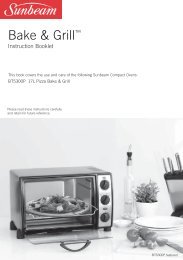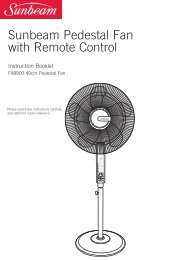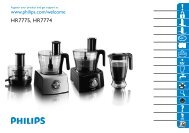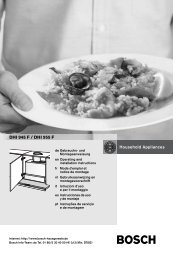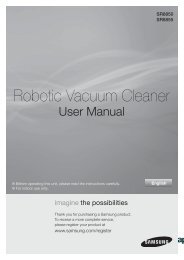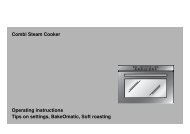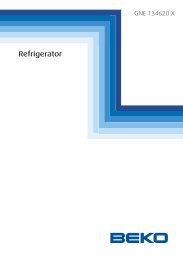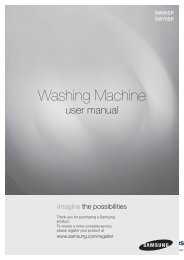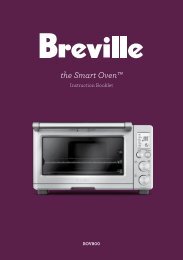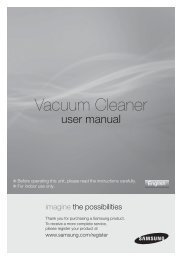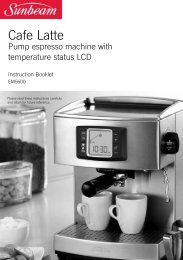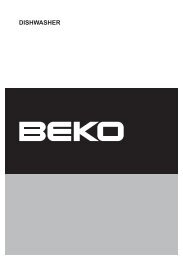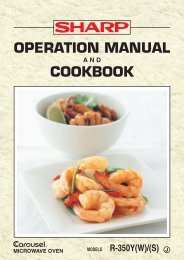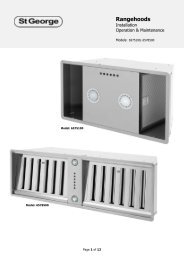USER MANUAL - Appliances Online
USER MANUAL - Appliances Online
USER MANUAL - Appliances Online
Create successful ePaper yourself
Turn your PDF publications into a flip-book with our unique Google optimized e-Paper software.
<strong>USER</strong> <strong>MANUAL</strong><br />
GHR16S, GHR16W, GHR17S,<br />
GHR17W, GHR765S, GHR775S,<br />
GHR95S, GHR95W, GHR795S<br />
GAS COOKTOPS
CONTENTS<br />
CONGRATULATIONS<br />
Congratulations and thank you for choosing our Product.<br />
We are sure you will find your new cooktop a pleasure<br />
to use and a great asset to your cooking. Before you use<br />
the cooktop, we recommend that you read through the<br />
whole user manual which provides the description of the<br />
cooktop and its functions.<br />
To avoid the risks that are always present when you<br />
use a gas appliance, it is important that the cooktop is<br />
installed correctly and that you read the safety instructions<br />
carefully to avoid misuse and hazards. For future reference,<br />
please store this booklet in a safe place.<br />
This appliance complies with the requirements of<br />
Australian Standard AS 4551.<br />
CONDITIONS OF USE<br />
This appliance is intended to be used in household and<br />
similar applications such as:<br />
• Staff kitchen areas in shops, offices and other<br />
working environments<br />
• Farm Houses<br />
• By clients in hotels, motels and other residential<br />
type environments<br />
• Bed and breakfast type environments.<br />
Record model and serial number here:<br />
Model: .................................................................<br />
Serial number: .......................................................<br />
CONTENTS<br />
Important safety instructions . . . . . . . . . . . . . . . . . . . . . 3<br />
Installation and use summary . . . . . . . . . . . . . . . . . . . . . 4<br />
Cleaning and care . . . . . . . . . . . . . . . . . . . . . . . . . . . 5<br />
Troubleshooting . . . . . . . . . . . . . . . . . . . . . . . . . . . . 6<br />
Installation instructions . . . . . . . . . . . . . . . . . . . . . . . . 7<br />
Installation procedure . . . . . . . . . . . . . . . . . . . . . . . . . 8<br />
Gas connection . . . . . . . . . . . . . . . . . . . . . . . . . . . 10<br />
Operation on NG/SNG . . . . . . . . . . . . . . . . . . . . . . . . 10<br />
LPG conversion . . . . . . . . . . . . . . . . . . . . . . . . . . . 12<br />
Electrical connection . . . . . . . . . . . . . . . . . . . . . . . . 13<br />
Testing appliance operation . . . . . . . . . . . . . . . . . . . . . 14<br />
Warranty . . . . . . . . . . . . . . . . . . . . . . . . . . . . . . . 15<br />
IMPORTANT SAFETY INSTRUCTIONS<br />
Please read the user manual carefully and store in a<br />
handy place for later reference. The symbols you will<br />
see in this booklet have these meanings:<br />
WARNING<br />
This symbol indicates information concerning your personal safety<br />
CAUTION<br />
This symbol indicates information on how to avoid damaging<br />
the appliance<br />
TIPS & INFORMATION<br />
This symbol indicates tips and information about use of the appliance<br />
ENVIRONMENTAL TIPS<br />
This symbol indicates tips and information about economical and<br />
ecological use of the appliance<br />
Meanings of symbols used in this manual are shown below:<br />
This symbol indicates never to do this<br />
This symbol indicates always do this<br />
TIPS & INFORMATION<br />
IMPORTANT – CHECK FOR ANY DAMAGE OR MARKS. If you find<br />
the cooktop is damaged or marked, you must report it<br />
within 7 days if you wish to claim for damage/marks<br />
under the manufacturer’s warranty. This does not affect<br />
your statutory rights.<br />
ENVIRONMENTAL TIPS<br />
Information on disposal for users<br />
• Most of the packing materials are recyclable.<br />
Please dispose of those materials through your local<br />
recycling depot or by placing them in appropriate<br />
collection containers.<br />
• If you wish to discard this product, please contact your<br />
local authorities and ask for the correct method of disposal.<br />
This appliance is not intended for use by persons<br />
(including children) with reduced physical, sensory<br />
or mental capabilities, or lack of experience<br />
and knowledge, unless they have been given<br />
supervision or instruction concerning use of the<br />
appliance by a person responsible for their safety.<br />
Children should be supervised to ensure they do<br />
not play with this appliance.<br />
During use, this appliance becomes hot. Care should<br />
be taken to avoid touching hot surfaces. To avoid<br />
burns, young children should be kept away.<br />
This appliance must not be used as a space heater.<br />
Keep vents clear of obstructions.<br />
In order to avoid a fire, this appliance must be<br />
kept clean.<br />
Do not spray aerosols in the vicinity of this<br />
appliance while it is in operation.<br />
Do not store flammable materials in or under this<br />
appliance, e.g. aerosols.<br />
Do not allow pots to boil dry, as damage to both<br />
pan and cooktop may result.<br />
Do not operate the cooktop for an extended period<br />
of time without a pot or pan on the hotplate.<br />
Do not allow large cookware to overhang the<br />
cooktop onto the adjacent benchtop. This will<br />
cause scorching to the benchtop surface.<br />
Do not allow cooking pots or pans to intrude<br />
into the area which is close to the controls.<br />
Ensure burner caps and trivets are properly located.<br />
(See Figure1)<br />
For maximum stability, ensure pots and pans<br />
are centrally located on the trivets.<br />
Handles should be turned away from the front<br />
of the bench to avoid accidents.<br />
Do not modify this appliance.<br />
Only models fitted with flame safeguard can be<br />
used in marine craft, caravans or mobile homes.<br />
2 3 SAFETY<br />
Figure 1<br />
1 Burner<br />
WARNING<br />
2 Flame safeguard sensor<br />
(where fitted)<br />
3 Injector<br />
4 Ignition spark plug<br />
1<br />
2<br />
3<br />
4
INSTALLATION & USE<br />
INSTALLATION<br />
NOTE: You must read these warnings carefully before<br />
installing or using the cooktop. If you need assistance,<br />
contact your Customer Care Department.<br />
The manufacturer will not accept liability, should the<br />
instructions below or any other safety instructions<br />
incorporated in this book be ignored.<br />
INSTALLATION<br />
• An authorised person must install this appliance and<br />
MUST provide a certificate of compliance. This certificate<br />
should be retained along with purchase information.<br />
• Before using the appliance, ensure that all packing<br />
materials are removed from the appliance.<br />
• In order to avoid any potential hazard, the installation<br />
instructions in this booklet, and any labels on the<br />
appliance must be followed.<br />
• Ensure that all specified vents, openings and air spaces<br />
are not blocked.<br />
• Where the appliance is built into a benchtop, the<br />
benchtop material must be capable of withstanding 85°C.<br />
• Ensure that the duplicate rating label (in the instruction<br />
pack) is attached to a readily-accessible adjacent surface,<br />
so that the cooktop can be easily identified in the case<br />
of a service call.<br />
SERVICING<br />
• Servicing MUST only be carried out by authorised<br />
personnel.<br />
• To maintain safe operation, it is recommended that the<br />
product be inspected every five years by an authorised<br />
service person.<br />
• If the supply cord is damaged, it must be replaced by an<br />
authorised service person in order to avoid a hazard.<br />
CLEANING<br />
• Always ensure the appliance is turned off before cleaning.<br />
• This appliance contains aluminium fittings. Do not use<br />
caustic-based cleaners.<br />
• Do not use steam cleaners, as this may cause moisture<br />
build up on electrical components.<br />
• Always clean the appliance immediately after any<br />
food spillage.<br />
CAUTION<br />
• DO NOT place burners in a dishwasher.<br />
CONTROLS<br />
• Each burner is controlled by a control knob.<br />
The markings on the control panel indicate which<br />
burner the knob controls, and the settings for that<br />
burner. (See Figure 2)<br />
USING YOUR COOKTOP<br />
Note: Gas controls turn anticlockwise from ‘Off’ and<br />
have limited movement.<br />
Figure 2<br />
LIGHTING BURNERS<br />
Electronic ignition<br />
These cooktops are fitted with mains powered ignition.<br />
When the appliance has been connected and the power<br />
is on, depressing any knob will release sparks to all burners.<br />
To light a burner, depress the corresponding knob and<br />
turn to the ‘High’ position (while depressing the knob).<br />
The knob may be released once the flame is established.<br />
Flame safeguard models<br />
The knob must be turned to the ‘High’ position,<br />
then pushed down as far as possible for approximately<br />
5 seconds. If the flame goes out when the knob is released,<br />
simply depress the knob again, this time holding it down<br />
with slightly more force for the same length of time.<br />
The height of the flame can be varied by turning the<br />
control knob toward the ‘Low’ position.<br />
WARNING<br />
• Keep hands clear of burners when lighting.<br />
• If burner does not light within 5 seconds, turn knob to ‘Off’<br />
position, allow gas to disperse, then try lighting again.<br />
• Burners MUST be operated between ‘HIGH’ and ‘LOW’<br />
settings only.<br />
In the absence of electrical power, carry out the ignition<br />
directly to the burner with a hand-held ignition source.<br />
Choice of burners<br />
For your convenience there is a choice of burners:<br />
• A small burner for special low heat and slow cooking.<br />
• A medium burner for normal cooking and simmering.<br />
(one on 4-burner models and two on 5-burner models).<br />
• A large burner for fast heating and large pots and pans.<br />
• A wok burner for very fast heating using a wok or large<br />
pot or pan.<br />
To conserve gas, place the pan centrally over the burner<br />
and adjust the flame so that it does not extend past the<br />
edge of the pan (Figure 3). Do not boil food too rapidly.<br />
A vigorous boil will not cook food any faster, and will<br />
waste energy.<br />
Pots and pans<br />
All common pots and pans: aluminium, stainless steel,<br />
cast iron, ceramic, etc., may be used on your new gas<br />
model cooktop. Ensure that the pots or pans are steady<br />
and have flat bases to avoid dangerous spill-over of<br />
hot liquids and wasted energy. A wok support has been<br />
supplied with this appliance for use when cooking with<br />
a round-bottom wok. The support is not necessary when<br />
cooing with a flat-bottom wok.<br />
Figure 3<br />
WARNING<br />
Never use asbestos mats, wire mats or grids, aluminium foil<br />
as it can lead to overheating, cracked enamel. The warranty<br />
will be void if these items are used and cause a failure. Woks<br />
should only be used on the wok burner and wok support trivet.<br />
CLEANING & CARE<br />
CAUTION<br />
Ensure the appliance is off and cool before cleaning.<br />
Enamel<br />
Persistent stains may require rubbing with a nylon scourer or<br />
creamed powder cleansers. Household enamel cleaners are<br />
available, follow the manufacturer’s instructions in their use.<br />
CAUTION<br />
Harsh abrasive cleaners, powder cleaners,<br />
steel wool or wax polishes should not be used.<br />
Stainless steel<br />
Note: Ensure any oil is cleaned off the hob before first use,<br />
otherwise it may cause the hob to turn a yellowish colour.<br />
All grades of stainless steel may stain, discolour or attain<br />
an adhering layer of grime in normal operation. To achieve<br />
maximum surface appearance, stainless steel must be kept<br />
clean by regularly using the following cleaning procedures,<br />
thus ensuring good performance and long service life.<br />
Wash with warm soapy water and rinse with clean water.<br />
Where the stainless steel has become extremely dirty with<br />
signs of surface discolouration, (due to periods of neglect<br />
or misuse) use a stainless steel cleaner.<br />
CAUTION<br />
DO NOT use abrasive scourers or steel wool.<br />
When removing these stains be sure to follow the polish<br />
or brushing lines.<br />
Trivets and burners<br />
These can all be lifted off and removed for separate cleaning.<br />
This appliance is fitted with single-piece burners (except<br />
triple ring wok burner) for ease of cleaning. The burners<br />
and trivets are removable for easy cleaning.<br />
Note: When refitting the burners, ensure that they are<br />
correctly seated.<br />
Ensure burners are thoroughly dried after cleaning or spillage.<br />
When cleaning the burners, ensure that all the flame ports<br />
are free of any blockage. If necessary, use a toothpick or<br />
brush to clear ports. The outer surface of the burners have<br />
a polished finish and extra care needs to be taken to avoid<br />
scratching this surface during cleaning. In instances of heavy<br />
soiling, it may be necessary to apply a non-abrasive cleaning<br />
compound and rub with a cloth until the soiling is removed<br />
and then finish with a soft, dry cloth.<br />
Note: DO NOT place burners in the dishwasher.<br />
Ignition<br />
GENTLY clean the spark plug and flame safe guard<br />
sensor (where fitted) with a damp cloth to avoid lighting<br />
difficulties. Ensure the electrode is dry before use.<br />
Injector<br />
Ensure the injector remains free of any foreign material.<br />
If necessary, use a thin piece of wire to clear the orifice.<br />
4 5 CLEANING & CARE
TROUBLESHOOTING<br />
If you have a problem with the cooktop, check the table below. You may be able to solve the problem and this will<br />
save you from paying for a service call. You will have to pay for a service call even in the warranty period if the<br />
problem is one listed below.<br />
FAULT POSSIBLE CAUSES REMEDY<br />
Burner will not light<br />
even though the sparker<br />
is working .<br />
No spark is obtained<br />
when control knob<br />
is activated<br />
• Knob not held down long enough<br />
in ‘High’ position for flame safeguard<br />
(where fitted) to engage<br />
• Repeat lighting procedure and hold knob<br />
down for 5 seconds in ‘High’ position<br />
(refer page 4)<br />
• Gas supply valve turned off • Turn on gas supply to appliance<br />
• Wrong knob turned • Ensure the knob you are turning corresponds<br />
to the burner you want to light<br />
• Port blockage in ignition area • Ensure that ports in ignition area are clean<br />
and dry<br />
• Ignition spark plugs wet or dirty • Dry or clean ignition spark plugs<br />
• Electricity supply is disconnected or<br />
switched off<br />
• Switch on electricity or check fuses<br />
• Ignition spark plugs wet or dirty • Dry or clean ignition spark plugs<br />
Flames uneven or • Flame ports blocked or wet • Clean or dry flame ports<br />
tending to lift • Burner incorrectly fitted • Ensure this component is fitted correctly<br />
Flames not staying on • Knob not held down long enough • Repeat lighting procedure and hold knob<br />
when knob released in ‘High’ position for flame safeguard down for 5 seconds in ‘High’ position<br />
(where fitted) to engage<br />
(refer page 4)<br />
• Knob not set between ‘High’ and<br />
‘Low’<br />
• Knob MUST be set between these positions.<br />
• Dirt or spillage on flame safeguard<br />
sensor (where fitted)<br />
• Clean flame safe guard sensor tip<br />
Low heat, slow cooking • Incorrect cooking pot or pan being used • Refer to Figure 3 (page 5)<br />
Benchtop or knobs • Incorrect cooking pot or pan used • Check Figure 3 for correct pot or pan to be used<br />
overheating<br />
• Pot or pan not located on burner • Ensure pot or pan is centrally located<br />
properly<br />
on burner<br />
If the above points have been checked and there is still a problem with the cooktop, please call the Service Centre.<br />
INSTALLATION INSTRUCTIONS<br />
This appliance must be installed by an authorised person<br />
and in compliance with :<br />
1. AS/NZS 5601.1 Gas Installations Part 1: General<br />
Installations, and AS/NZS 5601.2 Gas Installations<br />
Part 2: LP Gas installations in caravans and<br />
boats for non-propulsive purposes, or the relevant<br />
installation code for gas appliances in your country.<br />
2. The local gas fitting regulations, municipal building<br />
codes, electrical wiring regulations and any other<br />
relevant statutory regulations.<br />
3. The particular instructions as given below.<br />
Figure 4–60cm and 75cm models cut-out<br />
Gas supply connection location<br />
Figure 4–90cm models cut-out<br />
Gas supply connection location<br />
6 7 INSTALLATION<br />
560mm<br />
830mm<br />
CAUTION<br />
Cooktops are supplied for use with natural gas (NG).<br />
To use on LPG the injectors MUST be changed using<br />
the conversion kit supplied. Refer LP Conversion on<br />
page 12.<br />
4. A certificate of compliance MUST be given to the<br />
customer after the appliance is successfully installed.<br />
5. This appliance must be earthed.<br />
*<br />
*<br />
480mm<br />
480mm
INSTALLATION PROCEDURE<br />
1. The bench cutout should be made as per cutout<br />
dimensions in Figure 4.<br />
2. Adjacent walls, cupboards and protection for<br />
combustible materials.<br />
Ensure that the appliance is installed in accordance<br />
with clauses 6.2.5 and 6.10.1.1 of AS/NZS<br />
5601.1, or clauses 6.9.1 and 6.9.5 of AS/NZS<br />
5601.2 with regard to clearances to combustible<br />
surfaces and materials, and clearances to<br />
rangehoods and exhaust fans.<br />
To ensure clearances of 200mm from burners to<br />
vertical combustible surfaces observe the minimum<br />
dimensions shown in Figure 5.<br />
Clearances to combustible surfaces may be reduced<br />
if combustible surfaces are protected in accordance<br />
with clause 6.10.1.2 of AS/NZS 5601.1, or clause<br />
6.9.2 of AS/NZS 5601.2.<br />
3. Optional Barrier<br />
A barrier can be installed to prevent accidental contact<br />
with the cooktop base, where the base of the cooktop<br />
is accessible from below (i.e. inside a cupboard, etc).<br />
An impression has been incorporated into the base to<br />
ensure a minimum clearance of 15mm is maintained<br />
between the base and the barrier. This barrier may<br />
be made of any non-combustible, rigid material.<br />
4. Fitting the cooktop into the bench<br />
Carry out as follows:<br />
• Place the seals supplied around the bench cut-out<br />
as shown in Figure 6, taking care that the seals<br />
meet without overlapping.<br />
• Fit the pull-down clamps supplied to ensure<br />
that the cooktop cannot move after installation.<br />
WARNING<br />
Failure to fix the cooktop to the bench could result<br />
in loosening of the gas connection through movement<br />
of the cooktop and a gas leak may result.<br />
• Use the 4 clamps and screws supplied in the parts<br />
bag for 4 burner models, and 6 clamps and screws<br />
for 5 burner models.<br />
• To assemble, attach the clamps to each corner<br />
of the burner box via the screws provided.<br />
• Fix the clamps as shown in Figure 7. The clamp<br />
location points are shown in Figure 8.<br />
• Remove excess seal.<br />
• If the benchtop is less than the standard 33mm<br />
thickness, use a packer between the bench and<br />
the pull down clamps to ensure the cooktop is<br />
properly secured.<br />
Figure 5–60cm models<br />
131mm<br />
Figure 5–75cm models<br />
91mm<br />
Figure 5–90cm models<br />
111mm<br />
combustible surface<br />
combustible surface<br />
combustible surface<br />
131mm<br />
131mm<br />
131mm<br />
119mm<br />
79mm<br />
99mm<br />
Figure 6–60cm models<br />
Figure 6–75cm models<br />
Figure 6–90cm models<br />
INSTALLATION 8 9 INSTALLATION<br />
11mm<br />
11mm<br />
86mm 86mm<br />
26mm 26mm<br />
10mm<br />
10mm<br />
10mm<br />
Figure 7<br />
benchtop<br />
seal<br />
Figure 8–60cm and 75cm models<br />
clamp location<br />
hob<br />
clamp<br />
trivet<br />
clamp location Bottom view<br />
screw<br />
Figure 8–90cm models<br />
possible clamp locations<br />
possible clamp locations<br />
Bottom view<br />
burner box<br />
clamp location<br />
clamp location
GAS CONNECTION<br />
GAS CONNECTION<br />
This appliance is supplied for use with Natural Gas.<br />
However, it can be converted for use with LPG.<br />
Refer to LP conversion on pages 12 and 13.<br />
Supply pipe sizing<br />
The total hourly gas consumption for the appliance is<br />
shown on the data label. The required supply pressure<br />
(i.e. at inlet to appliance regulator) for each gas type<br />
is shown on the data label, and given in Table 2.<br />
Use this information in conjunction with the length of run,<br />
number of elbows, tees and bends, the available service<br />
pressure and the supply requirements of other installed<br />
appliances to determine a suitable pipe size. For assistance<br />
in this matter refer to the appropriate section of AS/NZS<br />
5601.1 or AS/NZS 5601.2.<br />
An AGA certified class B or D flexible connection may be<br />
used to connect the cooktop in accordance with AS/NZS<br />
5601.1, in particular section 5.9 and clause 6.10.1.8,<br />
or AS/NZS 5601.2, in particular section 2.11. Where<br />
a hose assembly is used and the cooktop is in the<br />
installed position, the hose assembly shall be suitable for<br />
connection to a fixed consumer piping outlet located at<br />
a point 800 – 850mm<br />
above the floor and in the region outside the width of<br />
the appliance to a distance of 250mm. The point of<br />
connection to consumer piping must be accessible<br />
with appliance installed.<br />
Elbow positioning<br />
It is possible to reposition the elbow if required by<br />
loosening the locking nut and elbow by using two spanners.<br />
Re-tighten the entire assembly after the elbow has been<br />
repositioned. When fitting elbow to appliance, ensure<br />
that the sealing washer is fitted.<br />
OPERATION ON N.G./S.N.G.<br />
Regulator<br />
An appliance regulator is provided. The regulator must be<br />
positioned so that the pressure test nipple is accessible<br />
when the appliance is installed. Connect the gas supply<br />
to the ½” B.S.P. internal thread inlet of the regulator. Refer<br />
to ‘bench cutout’ (Figure 4) for connection point position.<br />
Assembly of Regulator<br />
The assembly of the regulator to the cooktop manifold<br />
is achieved via the elbow union and sealing washer<br />
supplied, refer to figure 9 (page 11).<br />
The ½” parallel thread connects to the manifold,<br />
and the sealing washer is placed between the<br />
manifold end and the flat face on the elbow.<br />
The ½” tapered thread connects to the outlet of the<br />
regulator, and is sealed on the thread using approved<br />
thread sealing tape or approved thread sealing compound.<br />
The inlet of the regulator is a ½” parallel thread and<br />
is connected to consumer piping or hose assembly.<br />
Regulators are supplied pre-adjusted and configured<br />
by the component maker for use with Natural Gas.<br />
The appliance installer is not required to make an<br />
adjustment to obtain the correct outlet pressure setting.<br />
An arrow on the base of the regulator indicates the<br />
direction of gas flow when the inlet and outlet of the<br />
regulator is orientated correctly. When the regulator<br />
has been fitted check for leaks from the connections<br />
with soapy water.<br />
Checking the gas supply<br />
1. Check the manometer zero point is correct.<br />
2. Connect the manometer to the cooktop pressure point.<br />
This is located on the regulator.<br />
3. Turn on the gas supply and electricity and try to ignite<br />
the gas.<br />
TIPS & INFORMATION<br />
NOTE! It will take additional time to light the gas for<br />
the first time as air needs to be purged from the pipes.<br />
4. With the appliance operating check the outlet pressure<br />
• when all burners of the appliance are operating<br />
at maximum,<br />
• when the smallest burner of the appliance<br />
is operating at minimum.<br />
Under these conditions the outlet pressure should not<br />
vary from the nominal outlet pressure of 1.00kPa by<br />
more than +/– 0.20kPa.<br />
Figure 9<br />
Manifold endform<br />
If the regulator appears to not be performing satisfactorily,<br />
then check the following points.<br />
1. If the outlet pressure is consistently too low then the<br />
inlet pressure may be too low and adjustment of an<br />
upstream regulator may be needed, or an upstream<br />
regulator or valve with insufficient flow capacity may<br />
be present in the gas supply line. If this is suspected<br />
then it may be necessary to repeat the checks whilst<br />
measuring both the inlet and outlet pressure to determine<br />
if the inlet pressure is in the range 1.13 – 5kPa.<br />
2. Check that the regulator has been fitted to the gas<br />
supply line in the correct orientation, the arrow on the<br />
base of the body indicates the direction of gas flow.<br />
Once these checks have been completed, if the<br />
regulator still fails to perform in a satisfactory manner<br />
it should be replaced.<br />
10 11 GAS CONNECTION<br />
Female nut<br />
Flat face<br />
Sealing washer<br />
Outlet<br />
Inlet<br />
½” Parallel thread<br />
Regulator<br />
½” Tapered thread<br />
Seal using approved<br />
sealing tape or approved<br />
thread sealing compound
LPG CONVERSION<br />
CAUTION<br />
This appliance is fitted with Natural Gas burner injectors.<br />
Please follow the procedure below if a conversion to suit<br />
LP gas is required.<br />
The conversion kit contains appropriate LPG injectors and<br />
1 LPG sticker.<br />
To convert to LPG<br />
1. Remove the hotplate burners to access the hotplate<br />
injectors. Replace the factory fitted NG injectors with<br />
the appropriate injectors, as supplied (see Table 2).<br />
2. Unscrew the hex nut from the regulator. The hex nut,<br />
brass washer and nylon insert will disengage as<br />
an assembly.<br />
3. Unclip the nylon insert from the nut assembly<br />
by rotating the insert ¼ turn, and pulling it free.<br />
4. Turn over the insert, and clip back into position.<br />
5. Refit the hex nut assembly to the regulator ensuring<br />
that it is fully screwed down. The regulator is now<br />
set for connection to LP.<br />
6. Turn on the gas supply and at each new connection<br />
check for leaks using soapy water: each hotplate<br />
valve should be turned on, one at a time, and the<br />
injector hole blanked off for several seconds.<br />
7. The operation of the regulator can be confirmed by<br />
connecting a manometer to the pressure test point<br />
located on the side of the regulator body adjacent<br />
to the outlet. With the appliance operating check<br />
the outlet pressure<br />
• when all burners of the appliance are operating<br />
at maximum,<br />
• when the smallest burner of the appliance<br />
is operating at minimum.<br />
Table 2<br />
BURNER TYPE<br />
NATURAL GAS<br />
(Nominal test point pressure: 1.00kPa)<br />
Under these conditions the outlet pressure should not<br />
vary from the nominal outlet pressure of 2.60kPa by<br />
more than +/– 0.52kPa.<br />
8. If the regulator appears to not be performing<br />
satisfactorily then check the following points.<br />
• If the outlet pressure is consistently too low then<br />
the inlet pressure may be too low and adjustment<br />
of an upstream regulator may be needed, or<br />
an upstream regulator or valve with insufficient<br />
flow capacity may be present in the gas supply<br />
line. If this is suspected then it may be necessary<br />
to repeat the checks whilst measuring both the<br />
inlet and outlet pressure to determine if the inlet<br />
pressure is in the range 2.75–7.00kPa.<br />
• Check that the insert has been fitted correctly as<br />
per diagram figure 10. Check that the hex nut is<br />
fully screwed down.<br />
• Check that the regulator has been fitted to the<br />
gas supply line in the correct orientation, the arrow<br />
on the base of the body indicates the direction of<br />
gas flow.<br />
Once these checks have been completed, if the<br />
regulator still fails to perform in a satisfactory manner<br />
it should be replaced.<br />
9. One by one, turn the knobs to minimum and screw<br />
in the bypass screw (accessible when the knob is<br />
removed – refer figure 12) until a small stable flame<br />
results. Turn the knob to maximum and then back to<br />
minimum to ensure that the correct minimum flame<br />
is maintained.<br />
10. Attach the LPG sticker to the cooker, near the gas<br />
supply inlet. Cover the Natural Gas label that is<br />
factory fitted.<br />
LPG<br />
(Nominal test point pressure: 2.60kPa)<br />
Injector size (mm) Gas consumption (MJ/h) Injector size (mm) Gas consumption (MJ/h)<br />
Small burner 1.00 5.1 0.55 4.2<br />
Medium burner 1.35 9.0 0.70 6.5<br />
Large burner 1.60 12.1 0.90 10.7<br />
Wok burner 1.75 14.4 1.00 13.0<br />
Hex nut assembly,<br />
fully screwed down<br />
Hex nut assembly,<br />
removed from<br />
regulator and insert<br />
disassembled<br />
Insert oriented for<br />
natural gas operation<br />
Insert oriented for<br />
LPG operation<br />
ELECTRICAL CONNECTION (220-240 volts)<br />
The appliance is supplied with a standard 7.5Amp<br />
service cord terminated by a 3-pin plug for connection<br />
to a standard household socket. The electrical supply<br />
is required to power the electronic ignition system.<br />
NOTE: It will be necessary for servicing purposes to<br />
disconnect the electrical power supply. The power point<br />
should therefore be accessible after the appliance is<br />
installed, as specified in the local wiring regulations.<br />
Diagram 1 is a schematic of the wiring in the appliance.<br />
The weight of the unit is printed on the appliance<br />
packaging label.<br />
12 13<br />
Figure 10<br />
Diagram 1<br />
E<br />
N<br />
L<br />
Use of Hose Assemblies<br />
Ensure that the hose assembly is restrained from accidental<br />
contact with the flue outlet of an underbench oven or any<br />
other hot surface of an adjacent appliance.<br />
ELECTRICAL<br />
CONNECTION
TESTING APPLIANCE<br />
OPERATION<br />
TESTING APPLIANCE OPERATION<br />
After installation, test the appliance and ensure that it<br />
operates correctly before handing it over to the customer.<br />
The following procedure is recommended:<br />
1. Turn on the gas and electricity supply and attempt<br />
ignition on all burners, both separately and in<br />
combination. (For correct procedure, refer to page 4).<br />
Note that additional time needs to be allowed for the<br />
initial lighting as air has to be purged from the pipes.<br />
2. Observe the flame appearance on each burner.<br />
(Figure 11) If it is much larger or much smaller than<br />
expected, the injector size and supply pressure<br />
require checking. Where a flame is unsatisfactory,<br />
refer to the Troubleshooting Guide (Page 6) to correct<br />
the fault. If the Troubleshooting Guide does not solve<br />
the problem, call the Service Centre.<br />
3. When all the foregoing is satisfactory, check the<br />
turndown (minimum or low) setting on each burner,<br />
as this may need adjustment. Valves have a by<br />
pass controlling screw, which may be accessed<br />
by removing the knob. This screw will be located<br />
on a particular area of the valve. (Refer figure 12).<br />
Normally, this will have been correctly set at the<br />
factory for use on NG (Natural Gas) and should not<br />
require adjustment.<br />
If the appliance has been converted to LPG, then the<br />
bypass screw will have to be screwed in until a small,<br />
stable flame results.<br />
Please ensure the supply pressure has been checked<br />
PRIOR to any adjustment.<br />
4. If the appliance cannot be adjusted to perform safely,<br />
inform the customer of the problem and affix an<br />
appropriate warning notice to the appliance. If the<br />
fault appears to be dangerous the appliance should<br />
be disconnected. If a minor fault exists, the customer<br />
may wish to use the appliance while awaiting service.<br />
If a fault cannot be fixed, please call the Service Centre.<br />
5. The customer should be advised that, in the event<br />
of a fault, the local Service Organisation or the<br />
retailer from whom the appliance was purchased<br />
should be contacted.<br />
6. When satisfied that the unit is operating correctly, turn off<br />
and instruct the customer on correct operation as outlined<br />
in this booklet. Ask the customer to operate the controls<br />
to ensure that the correct procedure is understood.<br />
WARNING<br />
Servicing must only be carried out by an authorised<br />
service person.<br />
Injector sizes required for various gas types are shown in<br />
Table 2 (page 11). The appliance inlet pressure for each<br />
gas type is also shown.<br />
For model identification after installation, an additional<br />
data plate sticker has been provided. This sticker is to<br />
be stuck onto adjacent cabinetry.<br />
Figure 11<br />
Figure 12<br />
Flame size adjusted to maximum<br />
Flame size adjusted to minimum<br />
Bypass screw<br />
Warranty<br />
FOR SALES IN AUSTRALIA AND NEW ZEALAND<br />
APPLIANCE: BUILT-IN OVEN, COOKTOP<br />
AND FREESTANDING COOKER<br />
This document sets out the terms and conditions of the product<br />
warranties for Electrolux <strong>Appliances</strong>. It is an important document.<br />
Please keep it with your proof of purchase documents in a safe place<br />
for future reference should you require service for your Appliance.<br />
1. In this warranty<br />
(a) ‘acceptable quality’ as referred to in clause 10 of this warranty has<br />
the same meaning referred to in the ACL;<br />
(b) ‘ACL’ means Trade Practices Amendment (Australian Consumer<br />
Law) Act (No.2) 2010;<br />
(c) ‘Appliance’ means any Electrolux product purchased by you<br />
accompanied by this document;<br />
(d) ‘ASC’ means Electrolux’ authorised serviced centres;<br />
(e) ‘Electrolux’ means Electrolux Home Products Pty Ltd of 163<br />
O’Riordan Street, Mascot, NSW 2020, ABN 51 004 762 341 in<br />
respect of <strong>Appliances</strong> purchased in Australia and Electrolux (NZ)<br />
Limited of 3-5 Niall Burgess Road, Mount Wellington, in respect<br />
of <strong>Appliances</strong> purchased in New Zealand;<br />
(f) ‘major failure’ as referred to in clause 10 of this warranty has the<br />
same meaning referred to in the ACL and includes a situation when<br />
an Appliance cannot be repaired or it is uneconomic for Electrolux, at<br />
its discretion, to repair an Appliance during the Warranty Period;<br />
(g) ‘Warranty Period’ means:<br />
(i) where the Appliance is used for personal, domestic or household<br />
use (i.e. normal single family use) as set out in the instruction<br />
manual, the Appliance is warranted against manufacturing<br />
defects in Australia for 24 months and in New Zealand for 24<br />
months, following the date of original purchase of the Appliance;<br />
(ii) where the Appliance is used for commercial purposes (including<br />
being used to directly assist a business or where the Appliance is<br />
used in a multi-family communal or share type environment), the<br />
Appliance will then be warranted against manufacturing defects<br />
in Australia for 3 months and in New Zealand for 3 months,<br />
following the date of original purchase of the Appliance.<br />
(h) ‘you’ means the purchaser of the Appliance not having purchased<br />
the Appliance for re-sale, and ‘your’ has a corresponding meaning.<br />
2. This warranty only applies to <strong>Appliances</strong> purchased and used in Australia<br />
or New Zealand and is in addition to (and does not exclude, restrict, or<br />
modify in any way) any non-excludable statutory warranties in Australia<br />
or New Zealand.<br />
3. During the Warranty Period Electrolux or its ASC will, at no extra charge<br />
if your Appliance is readily accessible for service, without special<br />
equipment and subject to these terms and conditions, repair or replace<br />
any parts which it considers to be defective. Electrolux or its ASC may<br />
use remanufactured parts to repair your Appliance. You agree that<br />
any replaced <strong>Appliances</strong> or parts become the property of Electrolux.<br />
This warranty does not apply to light globes, batteries, filters or similar<br />
perishable parts.<br />
4. Parts and <strong>Appliances</strong> not supplied by Electrolux are not covered by<br />
this warranty.<br />
5. You will bear the cost of transportation, travel and delivery of the<br />
Appliance to and from Electrolux or its ASC. If you reside outside of the<br />
service area, you will bear the cost of:<br />
(a) travel of an authorised representative;<br />
(b) transportation and delivery of the Appliance to and from Electrolux or<br />
its ASC,<br />
In all instances, unless the Appliance is transported by Electrolux or an<br />
Electrolux authorised representative, the Appliance is transported at the<br />
owner’s cost and risk while in transit to and from Electrolux or its ASC.<br />
6. Proof of purchase is required before you can make a claim under<br />
this warranty.<br />
7. You may not make a claim under this warranty unless the defect claimed<br />
is due to faulty or defective parts or workmanship. Electrolux is not liable<br />
in the following situations (which are not exhaustive):<br />
(a) the Appliance is damaged by:<br />
(i) accident<br />
(ii) misuse or abuse, including failure to properly maintain or service<br />
(iii) normal wear and tear<br />
(iv) power surges, electrical storm damage or incorrect power supply<br />
(v) incomplete or improper installation<br />
(vi) incorrect, improper or inappropriate operation<br />
(vii) insect or vermin infestation<br />
(viii) failure to comply with any additional instructions supplied with<br />
the Appliance;<br />
(b) the Appliance is modified without authority from Electrolux in writing;<br />
(c) the Appliance’s serial number or warranty seal has been removed<br />
or defaced;<br />
(d) the Appliance was serviced or repaired by anyone other than<br />
Electrolux, an authorised repairer or ASC.<br />
8. This warranty, the contract to which it relates and the relationship<br />
between you and Electrolux are governed by the law applicable where<br />
the Appliance was purchased. Where the Appliance was purchased in<br />
New Zealand for business purposes the Consumer Guarantee Act does<br />
not apply.<br />
9. To the extent permitted by law, Electrolux excludes all warranties and<br />
liabilities (other than as contained in this document) including liability for<br />
any loss or damage whether direct or indirect arising from your purchase,<br />
use or non use of the Appliance.<br />
10. For <strong>Appliances</strong> and services provided by Electrolux in Australia,<br />
the <strong>Appliances</strong> come with a guarantee by Electrolux that cannot be<br />
excluded under the Australian Consumer Law. You are entitled to a<br />
replacement or refund for a major failure and for compensation for any<br />
other reasonably foreseeable loss or damage. You are also entitled to<br />
have the Appliance repaired or replaced if the Appliance fails to be of<br />
acceptable quality and the failure does not amount to a major failure.<br />
The benefits to you given by this warranty are in addition to your other<br />
rights and remedies under a law in relation to the <strong>Appliances</strong> or services<br />
to which the warranty relates.<br />
11. At all times during the Warranty Period, Electrolux shall, at its discretion,<br />
determine whether repair, replacement or refund will apply if an<br />
Appliance has a valid warranty claim applicable to it.<br />
12. For <strong>Appliances</strong> and services provided by Electrolux in New Zealand,<br />
the <strong>Appliances</strong> come with a guarantee by Electrolux pursuant to the<br />
provisions of the Consumer Guarantees Act, the Sale of Goods Act and<br />
the Fair Trading Act.<br />
13. To enquire about claiming under this warranty, please follow these steps:<br />
(a) carefully check the operating instructions, user manual and the terms<br />
of this warranty;<br />
(b) have the model and serial number of the Appliance available;<br />
(c) have the proof of purchase (eg an invoice) available;<br />
(d) telephone the numbers shown below.<br />
14. You accept that if you make a warranty claim, Electrolux and its ASC<br />
may exchange information in relation to you to enable Electrolux to meet<br />
its obligations under this warranty.<br />
Important Notice<br />
Before calling for service, please ensure that the steps listed in point 13 above have been followed.<br />
FOR SERVICE<br />
or to find the address of your nearest<br />
state service centre in Australia<br />
PLEASE CALL 13 13 49<br />
For the cost of a local call (Australia only)<br />
FOR SERVICE<br />
or to find the address of your nearest<br />
authorised service centre in New Zealand<br />
FREE CALL 0800 10 66 10<br />
(New Zealand only)<br />
SERVICE AUSTRALIA<br />
ELECTROLUX HOME PRODUCTS<br />
www.electrolux.com.au<br />
SERVICE NEW ZEALAND<br />
ELECTROLUX HOME PRODUCTS<br />
www.electrolux.co.nz<br />
FOR SPARE PARTS<br />
or to find the address of your nearest<br />
state spare parts centre in Australia<br />
PLEASE CALL 13 13 50<br />
For the cost of a local call (Australia only)<br />
FOR SPARE PARTS<br />
or to find the address of your nearest<br />
state spare parts centre in New Zealand<br />
FREE CALL 0800 10 66 20<br />
(New Zealand only)<br />
14 15 WARRANTY<br />
GOV_Warr_Apr11
For more information on all Westinghouse appliances,<br />
or for dimension and installation information, call into your retailer,<br />
phone or email our customer care team or visit our website:<br />
AUSTRALIA<br />
phone: 1300 363 640<br />
fax: 1800 350 067<br />
email: customercare@electrolux.com.au<br />
web: www.westinghouse.com.au<br />
NEW ZEALAND<br />
phone: 09 573 2384<br />
fax: 0800 363 600<br />
email: customercare@electrolux.co.nz<br />
web: www.westinghouse.co.nz<br />
TOP SERVICE<br />
Top Service encompasses the after sales service<br />
provided by The Electrolux Group to consumers<br />
including delivery, home service and spare parts.<br />
Westinghouse. We are part of the Electrolux family.<br />
Share more of our thinking at www.electrolux.com<br />
Part number: 305 4423 02 Rev D<br />
© 2011 Electrolux Home Products Pty Ltd ABN 51 004 762 341<br />
Print code: WMANIGCTUM_Jun11



